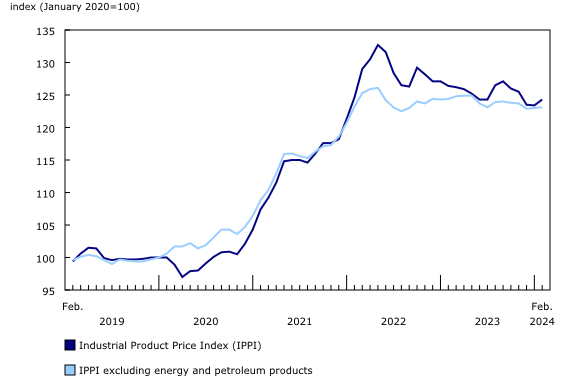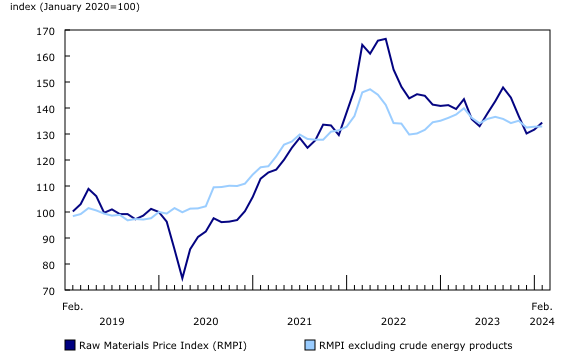Industrial product and raw materials price indexes, February 2024
Released: 2024-03-18
Prices of products manufactured in Canada, as measured by the Industrial Product Price Index (IPPI), rose 0.7% on a monthly basis in February and fell 1.7% relative to February 2023. Prices of raw materials purchased by manufacturers operating in Canada, as measured by the Raw Materials Price Index (RMPI), increased 2.1% month over month in February 2024 and decreased 4.7% year over year.
Industrial Product Price Index
The IPPI rose 0.7% month over month in February, following four months of consecutive declines. This increase was driven by higher prices for energy and petroleum products. Excluding energy and petroleum products, the IPPI edged up 0.1%.
The prices of energy and petroleum products were up 5.2% in February, after four straight monthly declines. The increase was mainly due to higher prices for refined petroleum energy products (+5.9%), including finished motor gasoline (+6.6%) and diesel fuel (+4.4%). As it is a key input, higher prices for conventional crude oil (+6.1%) influenced downstream refined petroleum products. Additionally, a combination of unexpected shutdowns and seasonal maintenance reduced the output of several prominent North American refineries in February. Consequently, stocks of gasoline and distillate fuel oil declined throughout February, and the scarcity contributed to price increases.
Prices for chemicals and chemical products rose 1.6% in February, primarily on higher prices for petrochemicals (+5.4%) and plastic resins (+5.9%). Strong export demand and higher freight costs due to shipping disruptions in the Red Sea both supported prices for plastic resins. Furthermore, rising petroleum prices likely impacted chemical prices, as petroleum products are key inputs for petrochemicals and other chemical products.
Several product groups declined month over month in February, partly moderating the IPPI's increase.
Prices for meat, fish and dairy products decreased 0.9% in February, the fourth consecutive monthly decline for the group. Prices were lower for fresh and frozen chicken (-7.3%) and fresh and frozen pork (-2.4%), with higher prices for fresh and frozen beef and veal (+4.0%) moderating the decrease. Chicken prices fell for the fifth consecutive month, mainly due to ample supply and relatively low demand in the winter months. According to Agriculture and Agri-Food Canada, chicken storage stocks rose 14.0% in February compared with the same month in 2023. Lower pork prices were partly attributable to continued low demand as well as sufficient supply. According to the United States Department of Agriculture (USDA), pork production in the first quarter of 2024 is expected to remain at roughly the same level as the fourth quarter of 2023, which was up significantly from the third quarter. Higher prices for beef in February 2024 were driven by stronger demand and short supply. In addition, domestic cattle prices remained high, mainly due to the prolonged supply shortage. As of January, the cattle herd in Canada fell to its lowest level since January 1, 1989. In the RMPI, cattle and calves prices (+2.6%) also rose on a monthly basis.
Intermediate food products (-1.3%), such as canola or rapeseed oil (-5.1%) and oilseed cake and meal (-5.5%), also decreased in February 2024. The high level of global supply exerted downward pressure on prices for canola and other oilseeds, as the United States posted a canola production record in 2023 and South American oilseed production was also strong. The USDA projected that global oilseed output would increase 3.4% in the 2023/2024 crop year compared with its 2022/2023 estimate.
Prices for primary non-ferrous metal products fell 0.3% month over month in February 2024. Unwrought gold, silver, and platinum group metals, and their alloys (-0.4%), were a key driver of the decrease, particularly unwrought silver and silver alloys (-0.5%), as well as unwrought platinum group metals, and their alloys (-3.1%). Weaker demand from the automotive sector weighed on the prices of platinum group metals for the first two months of 2024, as their primary application is in petroleum-powered vehicles. Prices also fell for other unwrought non-ferrous metals and non-ferrous metal alloys (-2.0%), such as zinc. In February, zinc inventories on the London Metal Exchange hit their highest point since midway through 2021, contributing to the price decline. In contrast, increased prices for unwrought nickel and nickel alloys (+2.0%) lessened the overall decrease for non-ferrous metals.
Year over year
The IPPI fell 1.7% in February 2024 relative to February 2023. This was the fifth consecutive year-over-year decline.
Prices for unwrought nickel and nickel alloys (-38.7%), which decreased through most of 2023, were a significant contributor to the year-over-year decline in the IPPI in February 2024. Other products that experienced notable year-over-year price decreases in February include jet fuel (-30.2%), diesel fuel (-9.6%), wood pulp (-16.5%) and other unwrought non-ferrous metals and non-ferrous metal alloys (-23.3%).
Mitigating the decline, prices rose on a yearly basis for numerous groups, including unwrought gold, silver, and platinum group metals, and their alloys (+4.2%), and light-duty trucks, vans and sport utility vehicles (+1.9%).
Raw Materials Price Index
In February, the RMPI rose 2.1% on a monthly basis, after posting a 1.2% increase in January.
Higher prices for crude energy products (+5.7%) led the increase in the RMPI in February. Conventional crude oil prices were up 6.1% and synthetic crude oil rose 10.1%. Despite the six-week consecutive increase in US crude inventories, the sustained high crude prices this month were partly influenced by the ongoing tensions in the Middle East and the expectation of OPEC+ to extend production restrictions into March. Furthermore, greater-than-anticipated demand from Asia influenced the upward trajectory of oil prices.
Crop products (-2.8%) continued to fall in February, posting a seventh consecutive monthly decrease. Lower prices for canola (-6.0%) were mainly behind the drop. Other crop products (-2.2%) and wheat (-3.7%) were also down compared with January. High domestic production and weak export demand put downward pressure on canola prices in February. Agriculture and Agri-Food Canada lowered their estimate for canola exports by 9.1% for the current production year, 2023/2024 (down from 7.7 million metric tons to 7.0 million metric tons).
Metal ores, concentrates and scrap edged down 0.1% in February. The decline was driven by iron ores and concentrates (-7.9%). Weak demand and high inventories in China partly drove iron ore prices down. Partially offsetting the decrease, nickel ores and concentrates rose 2.0%, posting the first monthly increase since April 2023 (+1.1%). A slowdown in production and lower level of stock in Indonesia, the world's top producer of nickel, put upward pressure on prices in February 2024. Concerns that nickel would be affected by new Western sanctions against Russia, another major producer of the metal, also played a part in higher prices.
Year over year
The RMPI decreased 4.7% year over year in February, the fifth consecutive year-over-year decline.
Nickel ores and concentrates (-38.7%) drove the downward movement in the RMPI. Canola (-30.2%), conventional crude oil (-3.6%) and synthetic crude oil (-10.3%) were other key contributors to the decrease.
Major upward contributors to the RMPI's year-over-year change include cattle and calves (+19.4%) and gold, silver, and platinum group metal ores and concentrates (+7.2%).
Did you know we have a mobile app?
Get timely access to data right at your fingertips by downloading the StatsCAN app, available for free on the App Store and on Google Play.
Note to readers
The Industrial Product Price Index (IPPI) and the Raw Materials Price Index (RMPI) are available at the Canada level only. Selected commodity groups within the IPPI are also available by region.
With each release, data for the previous six months may have been revised. The indexes are not seasonally adjusted.
The IPPI reflects the prices that producers in Canada receive as goods leave the plant gate. The IPPI does not reflect what the consumer pays. Unlike the Consumer Price Index, the IPPI excludes indirect taxes and all costs that occur between the time a good leaves the plant and the time the final user takes possession of the good. This includes transportation, wholesale and retail costs.
Canadian producers export many goods. Canadian producers often indicate goods' prices in foreign currencies, especially in US dollars, which are then converted into Canadian dollars. This is particularly the case for motor vehicles, pulp and paper products, and wood products. Therefore, fluctuations in the value of the Canadian dollar against its US counterpart affect the IPPI. However, the conversion to Canadian dollars reflects only how respondents provide their prices. This is not a measure that takes into account the full effect of exchange rates.
The conversion of prices received in US dollars is based on the average monthly exchange rate established by the Bank of Canada and available in Table 33-10-0163-01 (series v111666275). Monthly and annual variations in the exchange rate, as described in the release, are calculated according to the indirect quotation of the exchange rate (for example, CAN$1 = US$X).
The RMPI reflects the prices paid by Canadian manufacturers for key raw materials. Many of those prices are set on the world market. However, as few prices are denominated in foreign currencies, their conversion into Canadian dollars has only a minor effect on the calculation of the RMPI.
Products
Statistics Canada launched the Producer Price Indexes Portal as part of a suite of portals for prices and price indexes. This webpage provides Canadians with a single point of access to a variety of statistics and measures related to producer prices.
The video "Producer price indexes" is available on the Statistics Canada Training Institute webpage. It introduces Statistics Canada's producer price indexes: what they are, how they are made and what they are used for.
Next release
The industrial product and raw materials price indexes for March will be released on April 22.
Contact information
For more information, or to enquire about the concepts, methods or data quality of this release, contact us (toll-free 1-800-263-1136; 514-283-8300; infostats@statcan.gc.ca) or Media Relations (statcan.mediahotline-ligneinfomedias.statcan@statcan.gc.ca).
- Date modified:



